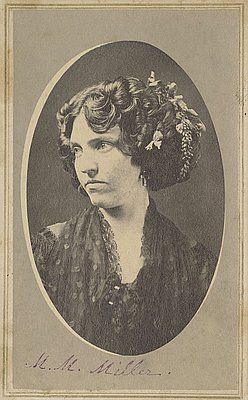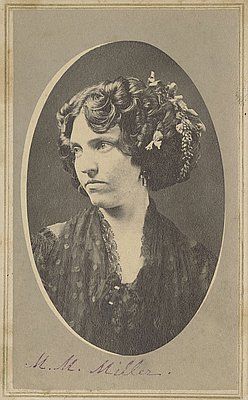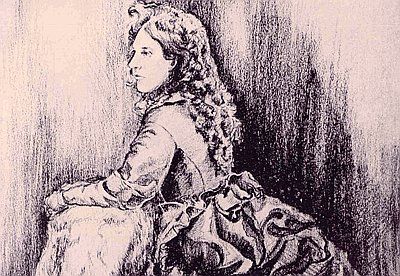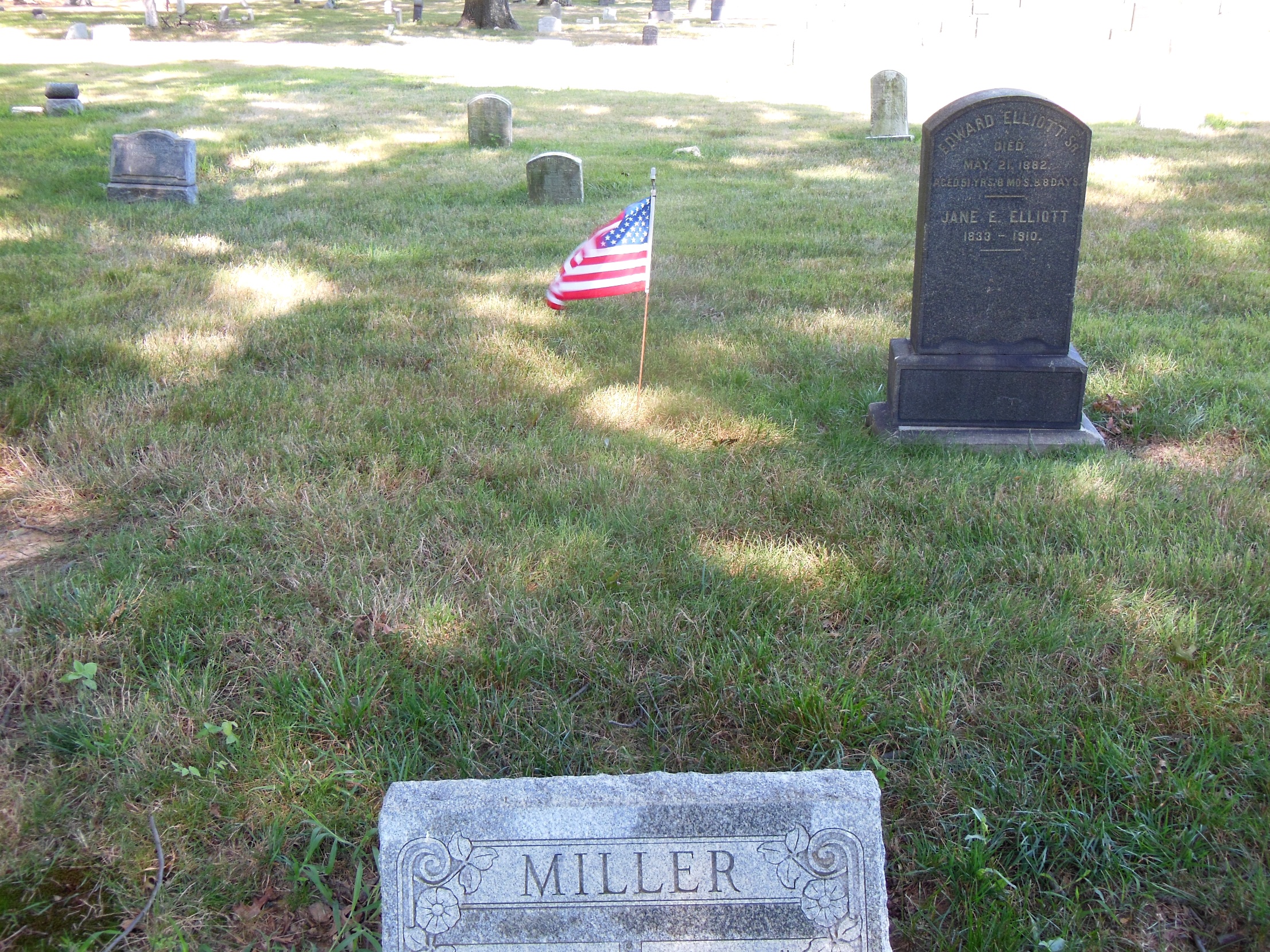She was born in 1842 at Brookville, Indiana to Aaron and Sarah Ann (Combs) Dyer. The Dyer family moved several times during her childhood, first to Oxford, Ohio, then to Green Bay, Iowa, before traveling to Oregon in 1859 by way of the Isthmus of Panama.
In 1861 Theresa began contributing poems and stories to various newspapers over or under the pseudonym "Minnie Myrtle." These writings attracted the attention of a young Cincinnatus Hiner Miller, and he wrote to her, beginning a year long correspondence. Eventually he resolved to meet her in person, and traveled to her home near Port Orford. They were married on Sunday September 14, 1862, after a whirlwind five day courtship.
In April 1863, after several months' residence at Eugene City, the newlyweds sailed for San Francisco to fulfill their literary ambitions, but stayed less than a year, returning in November of that year. The following year, on March 31, 1864, a daughter, Evelyn Maud Miller, was born, and two months later Minnie Myrtle and her husband set out with a group of friends and family for the small mining town of Canyon City in eastern Oregon. Two years later, a son, George Brick Miller, born (circa 1866). In May 1869, after nearly seven years of marriage, the two separated and Minnie Myrtle returned to her family at Port Orford, where she gave birth to her youngest son, Henry Mark (Hal) Miller, on July 25, 1869.
Still separated from her husband in April 1870, Minnie Myrtle filed for divorce. It was finalized on April 19, 1870 in Lane County, Oregon. While Cincinnatus Hiner Miller sailed for England and became famous as Joaquin Miller with the publication of his Songs of the Sierras in 1871, Minnie Myrtle moved with her three children to Portland, Oregon, and at the encouragement of suffragist Abigail Scott Duniway, turned to lecturing as a means of supporting herself and her children. Her most famous lecture, "Joaquin Miller, the Poet and the Man," was presented in San Francisco in 1872.
After a lengthy lecture tour of the eastern United States, followed by a short-lived residence in San Francisco between 1874 and 1875, Minnie Myrtle returned to Portland, Oregon, and there met Thomas E. L. Logan, whom she married February 10, 1877. After only a year of marriage, however, the two separated. Minnie moved to San Francisco to pursue a mechanical invention, but returned to Logan in late 1879 after her daughter Maud was charged with attempting to kidnap a young acquaintance and was placed in a convent in Canada by her father, Joaquin Miller.
In early 1881, after receiving a letter from Maud announcing her decision to lead the life of a nun, Minnie Myrtle traveled to Canada to see Maud and try to persuade her to change her mind. During this trip Minnie Myrtle contracted tuberculosis, and she died in Manhattan the following year at the New York Infirmary for Women and Children. She was buried on May 18, 1882 by her ex-husband, Joaquin Miller, at Brooklyn's Evergreen Cemetery, under the name Minnie Logan. There is no headstone to mark her grave.
Source: https://forgottenpoets.wordpress.com/2017/10/15/minnie-myrtle-miller-1842-1882/∼Minnie Myrtle Miller, the "Poetess of the Coquille," was born Theresa Dyer in Brookville, Indiana, on May 2, 1845. She was the daughter of Aaron Dyer Jr., and Sarah A. (Thompson) Dyer, who journeyed with their children from Ohio to Oregon in 1859 and settled on a farm in Curry County, not far from Port Orford.
A skilled horsewoman and an expert shot with a rifle, Theresa Dyer also earned praise for her writing. Using the name "Minnie Myrtle," she submitted poetry and prose to Oregon newspapers. Following her marriage and until her death at age thirty-seven, she wrote as "Minnie Myrtle Miller," sometimes signing as "M.M.M."
Critic John B. Horner acknowledged in Oregon Literature (1902) that this "sweet singer of the Coquille" had "the quick ear for the musical" and "showed unquestioned genius" as a poet. Had she lived a full life, Horner believed, "she would have been known as and recognized as one of the sweetest songsters of the West." In History of Oregon Literature (1935), Alfred Powers devoted a chapter to Minnie Myrtle and included eleven of her lyrical poems and two of her prose essays, all published in Oregon newspapers.
Minnie Myrtle's life was marked not only by her talent but also by her troubled eight-year marriage to Joaquin Miller. In 1862, her poetry attracted the attention of Cincinnatus Hiner Miller, the editor of Eugene City's Democratic Register, who years later fashioned himself as Joaquin Miller, the "Poet of the Sierras."
After a whirlwind courtship, the two were married on September 12, 1862, in Curry County, Oregon. In Memorie and Rime (1884), published after Minnie Myrtle's death, Joaquin Miller wrote: "I arrived on Thursday. On Sunday next, we were married! Oh, to what else but ruin and regret could such romantic folly lead."
After a move to California, where Minnie Myrtle and Joaquin Miller wrote for the San Francisco Golden Era, the couple settled in Grant County, where their "romantic folly" unraveled.
Minnie Myrtle Miller claimed that her husband had failed to provide for their three children; Joaquin Miller charged that Minnie Myrtle was an unfit mother and that the youngest child, Henry, was not his. He requested custody of the older children, Maud and George.
On April 19, 1870, the court granted a divorce, giving Minnie Myrtle care of Henry and her mother custody of Maud and George, with Joaquin to pay support. Soon Joaquin left Oregon and later sailed to England, where the London publication of Songs of the Sierras (1871) brought him international fame.
Impoverished and frequently ill, Minnie Myrtle was assisted by Oregon writers Belle W. Cooke, Ella Higginson, and Frances Fuller Victor. Editor Abigail Scott Duniway published Myrtle's poetry and prose in The New Northwest, encouraged her to take the lecture platform, and began a campaign in the summer of 1871 for the deserted wife and children of "an inconstant lord."
But Minnie Myrtle's desire for connection with Joaquin Miller was not extinguished, and in poetry, essays, and lectures she attributed Miller's behavior to literary talent and artistic temperament.
On May 15, 1882, Minnie Myrtle Miller died of pneumonia and consumption in the New York Infirmary for Women and Children.
She was buried in Brooklyn's Evergreen Cemetery. In Memorie and Rime, Joaquin Miller praised her talent and noted that she had entrusted "all her papers" to him before her death. The papers never surfaced, and no complete collection of her poetry and prose was ever published.
By Jean M. Ward
The Oregon Encyclopedia
She was born in 1842 at Brookville, Indiana to Aaron and Sarah Ann (Combs) Dyer. The Dyer family moved several times during her childhood, first to Oxford, Ohio, then to Green Bay, Iowa, before traveling to Oregon in 1859 by way of the Isthmus of Panama.
In 1861 Theresa began contributing poems and stories to various newspapers over or under the pseudonym "Minnie Myrtle." These writings attracted the attention of a young Cincinnatus Hiner Miller, and he wrote to her, beginning a year long correspondence. Eventually he resolved to meet her in person, and traveled to her home near Port Orford. They were married on Sunday September 14, 1862, after a whirlwind five day courtship.
In April 1863, after several months' residence at Eugene City, the newlyweds sailed for San Francisco to fulfill their literary ambitions, but stayed less than a year, returning in November of that year. The following year, on March 31, 1864, a daughter, Evelyn Maud Miller, was born, and two months later Minnie Myrtle and her husband set out with a group of friends and family for the small mining town of Canyon City in eastern Oregon. Two years later, a son, George Brick Miller, born (circa 1866). In May 1869, after nearly seven years of marriage, the two separated and Minnie Myrtle returned to her family at Port Orford, where she gave birth to her youngest son, Henry Mark (Hal) Miller, on July 25, 1869.
Still separated from her husband in April 1870, Minnie Myrtle filed for divorce. It was finalized on April 19, 1870 in Lane County, Oregon. While Cincinnatus Hiner Miller sailed for England and became famous as Joaquin Miller with the publication of his Songs of the Sierras in 1871, Minnie Myrtle moved with her three children to Portland, Oregon, and at the encouragement of suffragist Abigail Scott Duniway, turned to lecturing as a means of supporting herself and her children. Her most famous lecture, "Joaquin Miller, the Poet and the Man," was presented in San Francisco in 1872.
After a lengthy lecture tour of the eastern United States, followed by a short-lived residence in San Francisco between 1874 and 1875, Minnie Myrtle returned to Portland, Oregon, and there met Thomas E. L. Logan, whom she married February 10, 1877. After only a year of marriage, however, the two separated. Minnie moved to San Francisco to pursue a mechanical invention, but returned to Logan in late 1879 after her daughter Maud was charged with attempting to kidnap a young acquaintance and was placed in a convent in Canada by her father, Joaquin Miller.
In early 1881, after receiving a letter from Maud announcing her decision to lead the life of a nun, Minnie Myrtle traveled to Canada to see Maud and try to persuade her to change her mind. During this trip Minnie Myrtle contracted tuberculosis, and she died in Manhattan the following year at the New York Infirmary for Women and Children. She was buried on May 18, 1882 by her ex-husband, Joaquin Miller, at Brooklyn's Evergreen Cemetery, under the name Minnie Logan. There is no headstone to mark her grave.
Source: https://forgottenpoets.wordpress.com/2017/10/15/minnie-myrtle-miller-1842-1882/∼Minnie Myrtle Miller, the "Poetess of the Coquille," was born Theresa Dyer in Brookville, Indiana, on May 2, 1845. She was the daughter of Aaron Dyer Jr., and Sarah A. (Thompson) Dyer, who journeyed with their children from Ohio to Oregon in 1859 and settled on a farm in Curry County, not far from Port Orford.
A skilled horsewoman and an expert shot with a rifle, Theresa Dyer also earned praise for her writing. Using the name "Minnie Myrtle," she submitted poetry and prose to Oregon newspapers. Following her marriage and until her death at age thirty-seven, she wrote as "Minnie Myrtle Miller," sometimes signing as "M.M.M."
Critic John B. Horner acknowledged in Oregon Literature (1902) that this "sweet singer of the Coquille" had "the quick ear for the musical" and "showed unquestioned genius" as a poet. Had she lived a full life, Horner believed, "she would have been known as and recognized as one of the sweetest songsters of the West." In History of Oregon Literature (1935), Alfred Powers devoted a chapter to Minnie Myrtle and included eleven of her lyrical poems and two of her prose essays, all published in Oregon newspapers.
Minnie Myrtle's life was marked not only by her talent but also by her troubled eight-year marriage to Joaquin Miller. In 1862, her poetry attracted the attention of Cincinnatus Hiner Miller, the editor of Eugene City's Democratic Register, who years later fashioned himself as Joaquin Miller, the "Poet of the Sierras."
After a whirlwind courtship, the two were married on September 12, 1862, in Curry County, Oregon. In Memorie and Rime (1884), published after Minnie Myrtle's death, Joaquin Miller wrote: "I arrived on Thursday. On Sunday next, we were married! Oh, to what else but ruin and regret could such romantic folly lead."
After a move to California, where Minnie Myrtle and Joaquin Miller wrote for the San Francisco Golden Era, the couple settled in Grant County, where their "romantic folly" unraveled.
Minnie Myrtle Miller claimed that her husband had failed to provide for their three children; Joaquin Miller charged that Minnie Myrtle was an unfit mother and that the youngest child, Henry, was not his. He requested custody of the older children, Maud and George.
On April 19, 1870, the court granted a divorce, giving Minnie Myrtle care of Henry and her mother custody of Maud and George, with Joaquin to pay support. Soon Joaquin left Oregon and later sailed to England, where the London publication of Songs of the Sierras (1871) brought him international fame.
Impoverished and frequently ill, Minnie Myrtle was assisted by Oregon writers Belle W. Cooke, Ella Higginson, and Frances Fuller Victor. Editor Abigail Scott Duniway published Myrtle's poetry and prose in The New Northwest, encouraged her to take the lecture platform, and began a campaign in the summer of 1871 for the deserted wife and children of "an inconstant lord."
But Minnie Myrtle's desire for connection with Joaquin Miller was not extinguished, and in poetry, essays, and lectures she attributed Miller's behavior to literary talent and artistic temperament.
On May 15, 1882, Minnie Myrtle Miller died of pneumonia and consumption in the New York Infirmary for Women and Children.
She was buried in Brooklyn's Evergreen Cemetery. In Memorie and Rime, Joaquin Miller praised her talent and noted that she had entrusted "all her papers" to him before her death. The papers never surfaced, and no complete collection of her poetry and prose was ever published.
By Jean M. Ward
The Oregon Encyclopedia
Family Members
Advertisement
Advertisement










